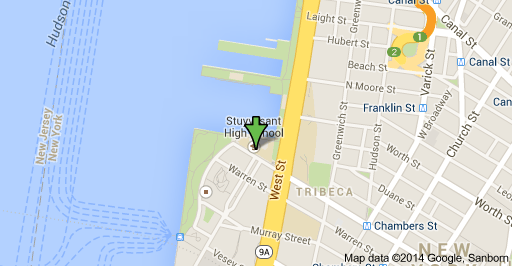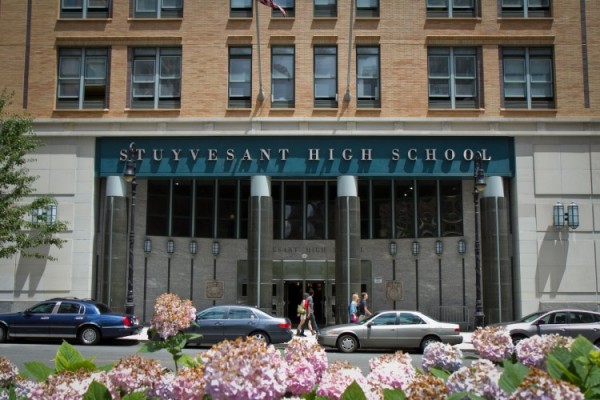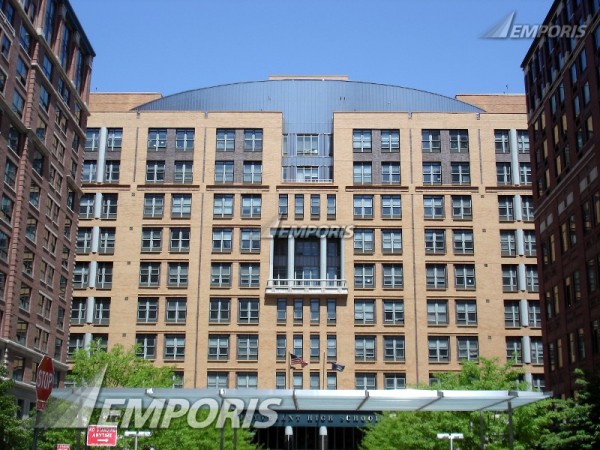
Top 100 Best High Schools 2013 – Stuyvesant High School – Newsweek – 38/100
Top 100 Best High Schools 2013 – Stuyvesant High School – Newsweek – 38/100
Stuyvesant High School
Stuyvesant High School /ˈstaɪvəsənt/, commonly referred to as Stuy /ˈstaɪ/,[7] is one of the nine Specialized High Schools in New York City. Operated by the New York City Department of Education, these schools offer tuition-free accelerated academics to city residents. The only way to be admitted into most of the Specialized High Schools, including Stuyvesant, is to take the Specialized High Schools Admissions Test (SHSAT). Stuyvesant traditionally holds the highest cutoff score out of the Specialized High Schools; each November, over 28,000 eighth and ninth graders take the 21⁄2-hour exam, and roughly 800 students (less than 3% of applicants) are accepted annually.
Local Map
345 Chambers St, New York, NY 10282, United States

Stuyvesant students undertake a college preparatory curriculum which includes English, history, biology, chemistry, physics, mathematics, foreign languages, two lab-based technology courses, and a semester each of introductory art, music, health, technical drawing, and computer science.[9] Students can select from fifty-five Advanced Placement courses and over fifty electives, including ones about the mathematics of financial markets, system level programming, molecular biology, and science writing. Most students complete the New York City Regents curriculum by junior year and take calculus during their senior year, and the school offers math courses through differential equations for the more advanced students.
Stuyvesant is noted for its strong academic programs, having produced many notable alumni including four Nobel laureates.[10][11] U.S. News & World Report ranked it as the fifty-eighth best High School nationwide in their 2012 list of America’s best “Gold-Medal” public high schools[12] and fifth best in its 2012 list of science, technology, engineering, and math (STEM) schools.[13] Stuyvesant students regularly place as semi-finalists and finalists in the Intel Science Talent Search. In the most recent three years, Stuyvesant sent the most semi-finalists out of any school in the nation, with 13 semi-finalists in 2012, 10 semi-finalists in 2013, and 11 in 2014.
Stuyvesant High School is named after Peter Stuyvesant, the last Dutch governor of New Netherland before the colony was transferred to England in 1664.[14] The school was established in 1904 as a manual training school for boys, hosting 155 students and 12 teachers. In 1907, it moved from its original location at 225 East 23rd Street to a building designed by C. B. J. Snyder at 345 East 15th Street, where it remained for 85 years. Its reputation for excellence in math and science continued to grow, and enrollment was restricted based on scholastic achievement starting in 1919.[15] Stuyvesant went on a double session plan in 1919 to accommodate the rising number of students, with some students attending in the morning and others in the afternoon and early evening. All students studied a full set of courses. Theses double sessions ran until 1956.[15][16] The school implemented a system of entrance examinations starting in 1934. The examination program was later expanded to include the newly founded Bronx High School of Science, and was developed with the assistance of Columbia University.[17] During the 1950s, the building underwent a $2 million renovation to update its classrooms, shops, libraries and cafeterias.[17] In 1956, a team of six students designed and began construction of a cyclotron. The team was headed by Martin Gersten and included John Sutherland, Charles Abzug and Robert Rudko. The faculty advisor was Abraham Kerner of the Chemistry Department. By 1962, a low-power test of the device succeeded. Matt Deming (1962) remembered that a later attempt at full-power operation “tanked the electrical system for the building and surrounding area”.[18][19] Prior to 1969, Stuyvesant did not accept female students. That year, 14 girls were admitted to Stuyvesant and 12 enrolled at the start of September, marking the school’s first co-educational year. By 2002, female enrollment had grown to 42%.[20] New York State Legislature passed the Hecht-Calandra act in 1972, designating Brooklyn Tech, Bronx Science, Stuyvesant, and The High School of Music & Art (now Fiorello H. LaGuardia High School of Music & Art and Performing Arts) as specialized high schools of New York City. The act called for a uniform exam to be administered for admission to Brooklyn Tech, Bronx Science and Stuyvesant High School.[21] The exam, named the Specialized High Schools Admissions Test (SHSAT), tested students in math and verbal abilities. Admission to LaGuardia High School is by audition rather than examination, in keeping with its artistic mission.[21] Stuyvesant moved into a new waterfront building in Battery Park City in 1992. The 15th St. building remains in use as of 2012, as “Old Stuyvesant Campus”, and houses the Institute for Collaborative Education, the High School for Health Professions and Human Services and P.S. 226. During the 2003–2004 school year, Stuyvesant celebrated the 100th anniversary of its founding with a full year of activities. Events included a procession from the 15th Street building to the Chambers Street one; a meeting of the National Consortium for Specialized Secondary Schools of Mathematics, Science and Technology; an all-class reunion; and visits and speeches from notable alumni. In recent years, keynote graduation speakers have included future Attorney General Eric Holder (2001),[22] former President Bill Clinton (2002),[23] United Nations Secretary General Kofi Annan (2004),[24] and Late Night comedian Conan O’Brien (2006).[25] A major cheating scandal, which eventually implicated seventy students, emerged in late June 2012. According to the Department of Education, a student used a smartphone to send text messages to other students during a state examination.[26] Some students involved were suspended as a result.
Enrollment
Stuyvesant has a total enrollment of over 3,000 students,[28] and is open to residents of New York City entering either ninth or tenth grade. Enrollment is based solely on performance on the Specialized High Schools Admissions Test (SHSAT).[29] The list of schools using the SHSAT has since grown to include all of New York’s specialized high schools except LaGuardia High School, where entry is by audition rather than examination. The test score necessary for admission to Stuyvesant has consistently been higher than that needed for admission to the other schools using the test.[30] Admission is currently based on an individual’s score on the examination and his or her pre-submitted ranking of Stuyvesant among the other specialized schools. Each year, about 26,000 of New York City’s eighth-graders sit for the test.[31] Ninth and rising tenth graders are also eligible to take the test for enrollment, though far fewer students are admitted this way.[32] The test covers math (word problems and computation) and verbal (reading comprehension, logical reasoning, unscrambling paragraphs) skills.
According to Article 12 of New York education law, “Admissions to the Bronx High School of Science, Stuyvesant High School, and Brooklyn Technical High School shall be solely and exclusively by taking a competitive, objective, and scholastic achievement examination, which shall be open to each and every child in the city of New York.”[33] The current admission policy is available from the NYC Department of Education.[30] According to the Department of Education, Stuyvesant accepts students solely based on their performance on the SHSAT, although former Mayor John Lindsay and community activist group ACORN have argued that the exam may be biased against African and Hispanic Americans.
Academics
Stuyvesant students undertake a college preparatory curriculum that includes four years of English, history, and laboratory-based sciences (biology, chemistry and physics are required), four years of mathematics (previously three, changed from Class of 2015 onward) and three years of a single foreign language, a semester each of introductory art, music, health and technical drawing, two semesters of computer science (previously one, changed from class of 2015 onward),[9] and two lab-based technology courses. Several exemptions from technology education exist for seniors.[41][42] Stuyvesant offers students a broad selection of elective courses. Some of the more unusual offerings include robotics, astronomy, New York City history, Women’s Voices, and the mathematics of financial markets.[43] Most students complete the New York City Regents courses by junior year and take calculus during their senior year. However, the school offers math courses through differential equations for the more advanced students. A year of technical drawing used to be required; students learned how to draft by hand in its first semester and how to draft using a computer (CAD) in the second. Now, students take a one-semester technical drawing class (a compacted version of the former drafting course), and a semester of introductory computer science, which introduces NetLogo and Racket. Beginning with the class of 2015, the one-semester computer science course will be replaced with a two-semester course.[9] Students can choose from 55 Advanced Placement courses[44] to earn college credits; a few are thus able to start college as sophomores. These AP courses can be as equally unusual as the electives; One example is the Advanced Placement English Literature and Composition – Physics and Mechanics course, an AP English course focusing on literature and media in the realm of physics and mechanics. Computer science enthusiasts can take three additional computer programming courses after the completion of Advanced Placement computer science: systems level programming, computer graphics, and software development. There is also a one year computer networking class which can earn students Cisco Certified Network Associate (CCNA) certification.
Stuyvesant’s foreign language offerings include Mandarin Chinese, French, German, Hebrew, Italian, Latin, Japanese, Korean, and Spanish. The school’s Muslim Student Association raised funds to support courses in Arabic, which began in 2005.[46] Stuyvesant’s Biology and Geo-science department offers courses in molecular biology (a course sequence composed of a molecular science class in the Fall and a molecular genetics class in the Spring), human physiology, medical ethics, medical and veterinary diagnosis, human disease, anthropology and sociobiology, vertebrate zoology, laboratory techniques, medical human genetics, botany, the molecular basis of cancer, nutrition science, and psychology. The Chemistry and Physics department offers organic chemistry, physical chemistry, astronomy, engineering mechanics, and electronics.[43]
Although Stuyvesant is primarily known for its math and science focus, the school also has a comprehensive humanities program, offering students courses in British and classical literature, Shakespearean literature, science fiction, philosophy, existentialism, debate, acting, journalism, creative writing, and poetry. The history core requires two years of global history (or one year of global followed by one year of European history), one year of American history, as well as a semester each of economics and government. Humanities electives include American foreign policy, civil and criminal law, prejudice and persecution, race, ethnicity and gender issues, small business management, and Wall Street.
Stuyvesant entered into an agreement with City College of New York in 2004, in which the college funds advanced after-school courses that are taken for college credit but taught by Stuyvesant teachers. Some of these courses include physical chemistry, linear algebra, advanced Euclidean geometry, and women’s history.[47][48] Before the 2005 revision of the SAT, Stuyvesant graduates had an average score of 1408 out of 1600 (685 verbal, 723 math).[20] In 2010, the average score on the SAT for Stuyvesant students was 2087 out of 2400, or 674, 735, and 678 on the Reading, Math and Writing sections, respectively.[49] Stuyvesant also was the high school with the highest number of Advanced Placement exams taken, and also the highest number of students reaching the mastery level.
Public recognition
According to a September 2002 high school ranking by Worth magazine, 3.67% of Stuyvesant students went on to attend Harvard, Princeton, and Yale Universities, ranking it as the 9th top public high school in the United States and 120th among all schools, public or private.[51] In December 2007, The Wall Street Journal studied the freshman classes at eight selective colleges (Harvard, Princeton, MIT, Williams College, Pomona College, Swarthmore College, U. Chicago, and Johns Hopkins), and reported that Stuyvesant sent 67, or 9.9% of its 674 seniors, to them.[52] Stuyvesant, along with other similar schools, has regularly been excluded from Newsweek’s annual list of the Top 100 Public High Schools. The May 8, 2008 issue states the reason as being, “because so many of their students score well above average on the SAT and ACT.”[53][54] US News & World Report, however, included Stuyvesant on its list of “Best High Schools” published in December 2009, ranking 31st.[55] In its 2010 progress report, the New York City Department of Education assigned it the highest possible grade of “A”.


